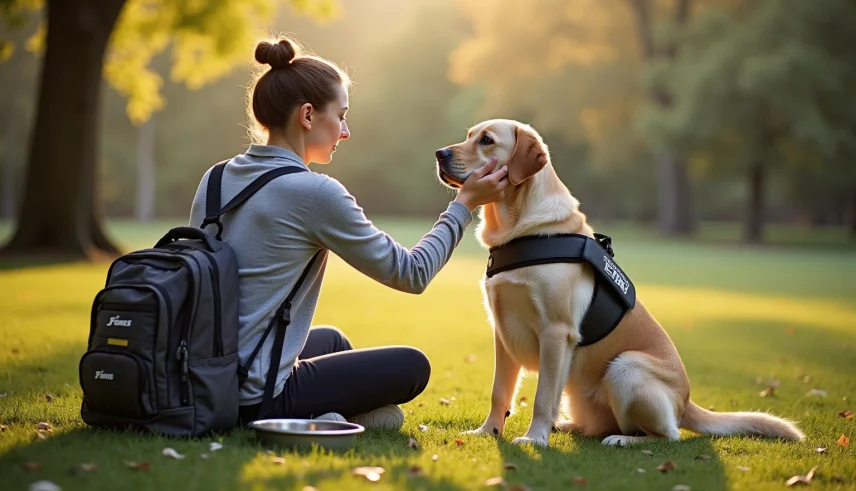
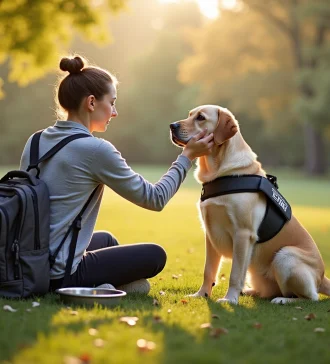
5 Steps on How to Train a Service Dog for Anxiety
by Lena Park
Last updated: July 17, 2025
Verified and Approved by:
Angela Morris,
MSW, LCSW
Fact Checked

Overview
The article presents a compassionate approach to training a service dog for anxiety, highlighting the significance of teaching specific tasks that alleviate anxiety symptoms, such as deep pressure therapy and alerting to panic attacks. This approach is backed by research showing that well-trained assistance dogs can greatly enhance the quality of life for individuals grappling with anxiety. They offer vital emotional support and practical interventions during distressing moments, fostering a sense of safety and comfort.
Introduction
The profound impact of service dogs on mental health, especially for those grappling with anxiety, is truly significant. These specially trained animals offer crucial support, from alerting their handlers to impending panic attacks to executing grounding techniques that foster a sense of calm. This guide explores the step-by-step process of training a service dog for anxiety, providing valuable insights into the traits to look for, the specific tasks these dogs can perform, and how to adapt training as needs evolve. How can one effectively harness the unique abilities of a service dog to transform their life and manage anxiety more effectively? Reflecting on this question can lead to a deeper understanding of the support available.
Understand the Role of Service Dogs for Anxiety
Service animals for stress are carefully trained to support individuals with mental health conditions, illustrating how to train a service dog for anxiety by performing specific tasks that help alleviate symptoms. These dogs offer emotional assistance, alert their handlers to impending panic attacks, and execute grounding techniques. Understanding these roles is crucial for handlers to learn how to train a service dog for anxiety to perform the specific tasks they wish, which is vital for effective training. For instance, an assistance dog may be trained to nudge their handler when they detect rising stress levels, serving as a gentle reminder to focus on the present moment.
Research indicates that learning how to train a service dog for anxiety can significantly enhance the quality of life for those with anxiety-related conditions. A study found that:
- 94 percent of psychiatric assistance canines provided relief from stress through tactile stimulation.
- 51 percent interrupted unwanted behavioral patterns.
Moreover, participants with assistance animals experienced a 3.7-point greater reduction in PTSD symptoms compared to those with emotional support animals, underscoring the unique benefits of assistance animals in managing stress. Notably, assistance canines perform trained tasks an average of 3.16 times daily, highlighting their active role in anxiety management.
Real-life stories illustrate the profound impact of assistance animals. Veterans have shared how their assistance animals help them navigate crowded spaces, offering a sense of safety and companionship that encourages them to engage in activities they once avoided. One veteran noted that their assistance dog ‘blocks individuals from getting too close and compels me to focus on her when I experience rage episodes.’ Such accounts emphasize the importance of assistance animals in fostering autonomy and improving mental health outcomes.
Ongoing research continues to explore how to train a service dog for anxiety and the roles of assistance animals in mental health support, showcasing their effectiveness in anxiety management. As more individuals recognize the benefits of these specially trained animals, the demand for assistance dogs is likely to grow, further affirming their essential role in therapeutic settings. Additionally, with flexible payment options starting at $32.25, obtaining a support dog is becoming increasingly accessible for those in need.
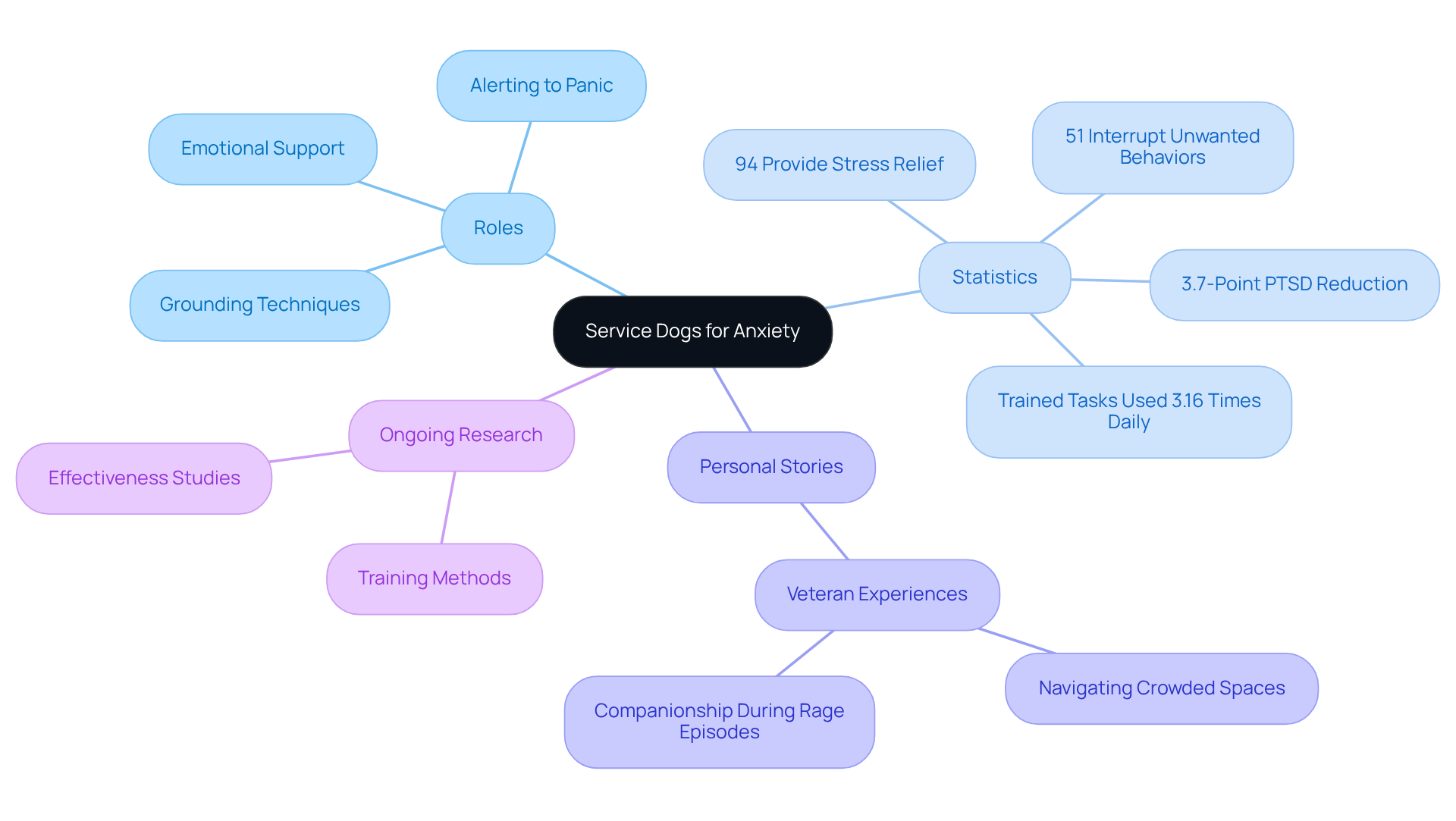
Identify Suitable Traits for a Service Dog
When selecting a dog to assist with stress, it’s essential to prioritize qualities such as calmness, attentiveness, and a strong desire to please, which are important factors to consider when learning how to train a service dog for anxiety. Breeds like Labrador Retrievers, Golden Retrievers, and Poodles are often recommended due to their friendly dispositions and high trainability. These breeds are not only sociable but also adaptable, allowing them to thrive in various environments and remain calm in stressful situations.
Research indicates that understanding how to train a service dog for anxiety is essential, as a well-trained assistance dog should exhibit a stable temperament, which is crucial for effectively supporting individuals dealing with stress. Evaluating these characteristics early on can significantly influence the development process, enhancing the dog’s ability to fulfill its supportive role.
Additionally, assistance canines typically undergo training for 1 to 2 hours daily, which helps to reinforce these vital traits and ensures they are prepared to assist their handlers in managing anxiety, demonstrating how to train a service dog for anxiety. It’s important to recognize that 50-70% of assistance dog candidates do not complete their training, highlighting the challenges inherent in this journey.
As Jean Bauhaus eloquently states, “Service dogs are trained to help people with physical or mental disabilities lead more independent lives,” emphasizing the crucial role these dogs play in enriching the lives of their handlers.
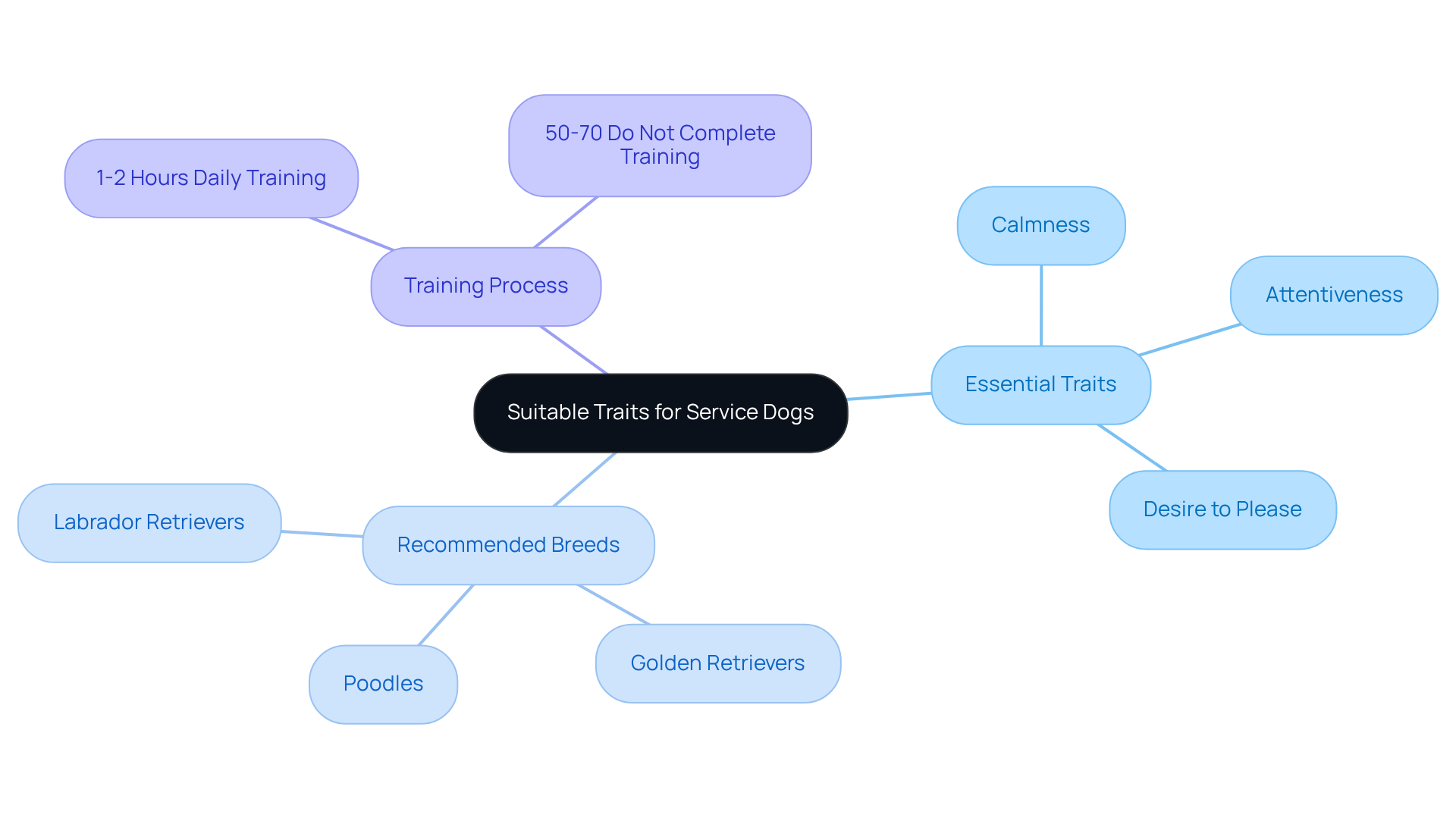
Follow a Step-by-Step Training Process
Begin your journey of training your service dog with essential obedience commands such as sit, stay, and come. These foundational skills are crucial for establishing effective communication between you and your beloved dog. As your dog masters these commands, consider gradually introducing more complex tasks as part of how to train a service dog for anxiety that can help in managing stress.
For instance, you might learn how to train a service dog for anxiety to perform specific behaviors, like nudging or licking, when they sense your anxiety levels rising. Consistency and positive reinforcement are key; rewarding your dog immediately after they exhibit the desired behavior can significantly enhance their learning experience.
Additionally, while there is no legal obligation for assistance dogs to be certified, obtaining certification from recognized organizations can provide credibility and assurance that your assistance dog meets specific training criteria. This structured approach not only enhances your dog’s skills but also nurtures a deeper bond between you and your service animal, creating a partnership built on trust and understanding.
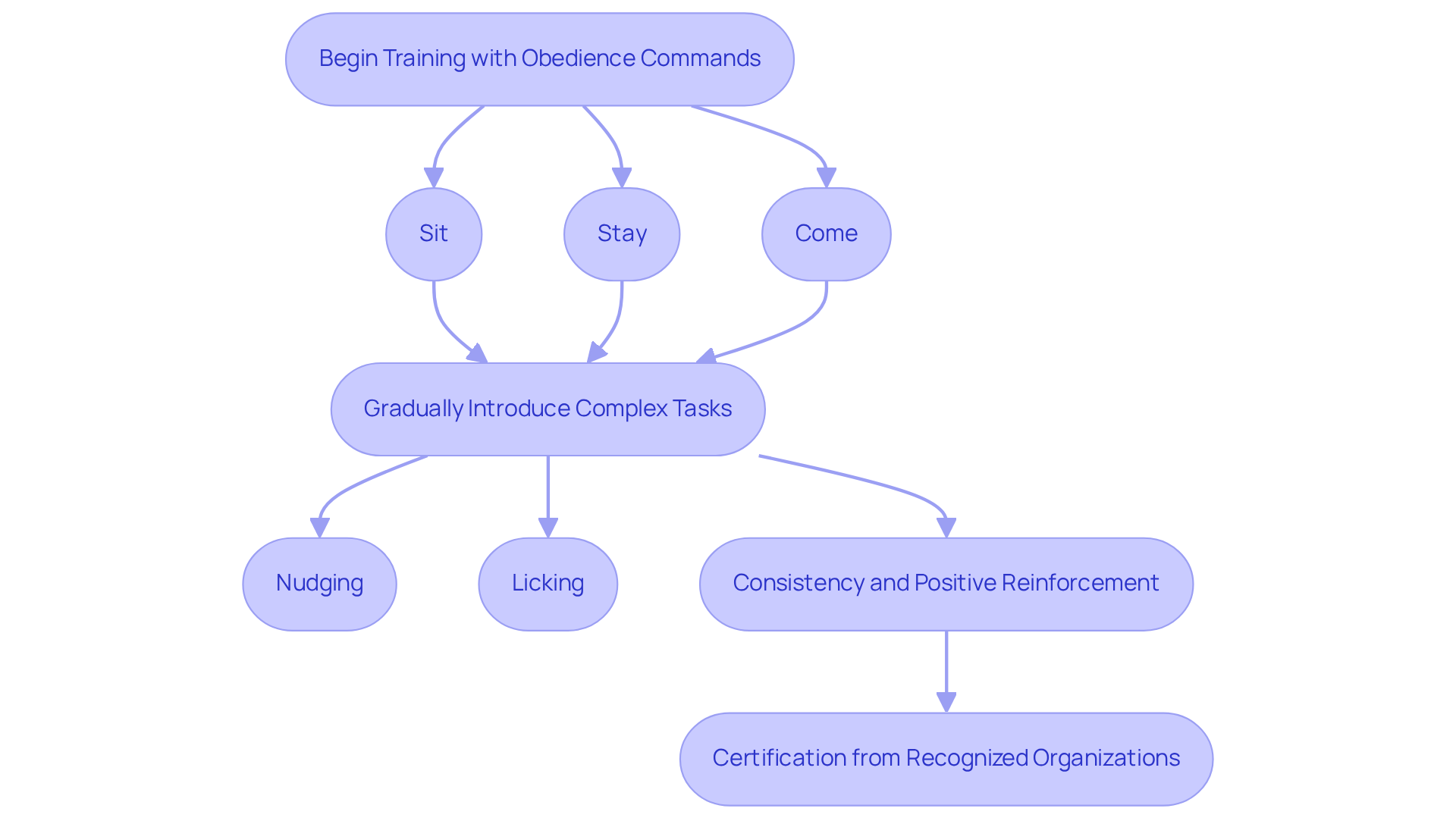
Teach Specific Tasks for Anxiety Management
Once your dog has mastered basic commands, it’s time to focus on how to train a service dog for anxiety by teaching specific tasks that can help manage stress effectively. One particularly beneficial task is deep pressure therapy, where your dog applies weight to your lap or chest during a stressful episode. This technique has been shown to significantly alleviate feelings of unease by providing a soothing effect. To teach deep pressure therapy, encourage your dog to lie on you or apply pressure with their body when you signal them. Reinforce this behavior with treats and praise to foster positive associations.
Moreover, it’s essential to train your dog to alert you to impending panic attacks. This can be achieved by teaching your dog to recognize signs of distress, such as pacing or heavy breathing. When your dog notices these cues, they should respond by nudging or pawing at you, prompting you to take necessary calming actions. Research indicates that individuals managing anxiety can greatly enhance their quality of life by learning how to train a service dog for anxiety, as these assistance dogs performing specific tasks become invaluable companions in challenging situations.
According to the Americans with Disabilities Act (ADA), an assistance animal is defined as a dog that has been individually trained to perform tasks for a person with a disability. Understanding this definition is crucial for appreciating the vital role of assistance animals in providing support. Additionally, obtaining an affordable ESA letter can ensure that your emotional support animal can accompany you in housing and travel, offering essential companionship and support. It’s also worth noting that many organizations dedicated to breeding and training assistance animals provide financial support and assistance animals at no cost, which can be an invaluable resource for those considering this option.
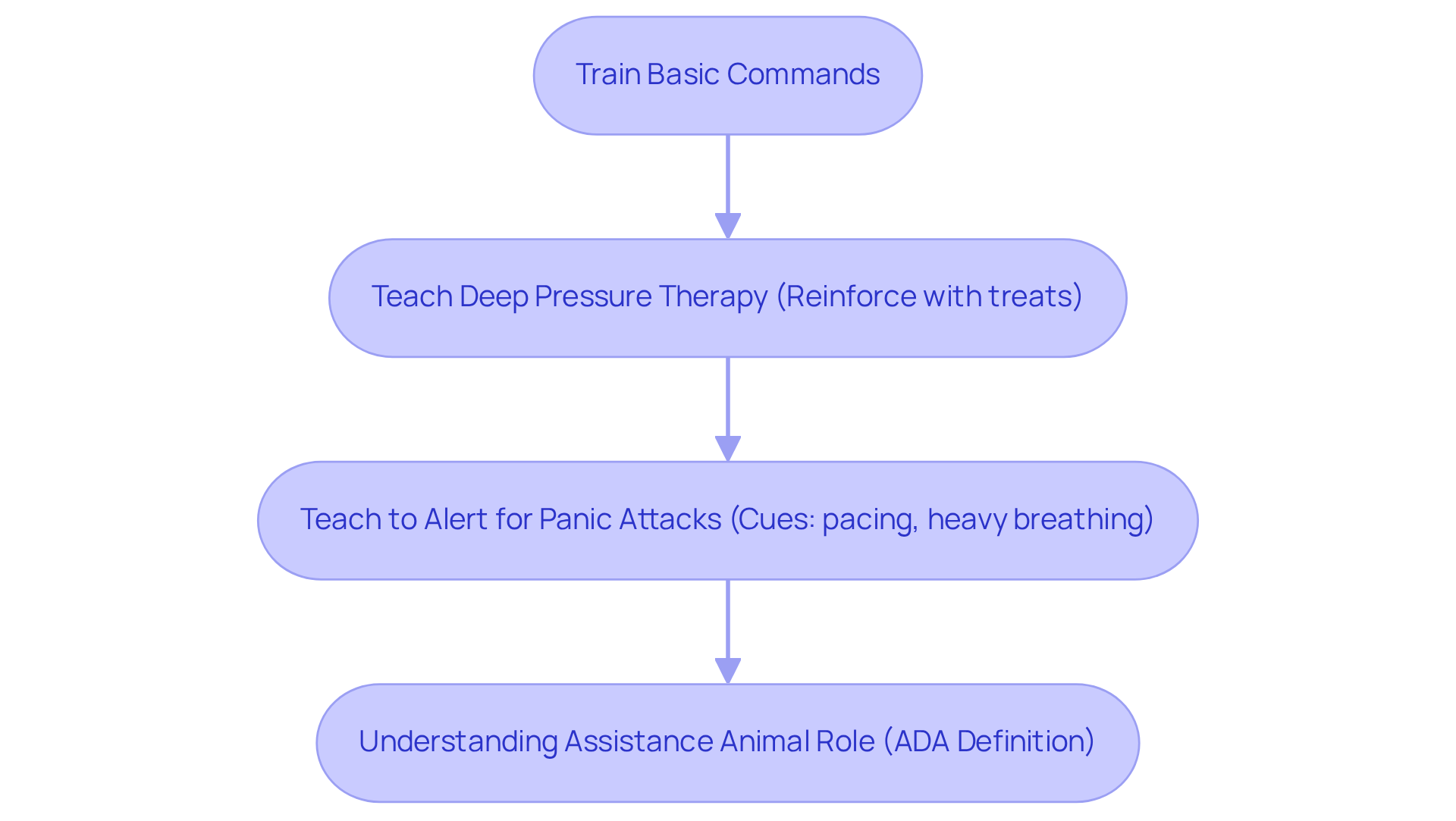
Reinforce Training and Adapt to Changing Needs
Training a service dog is a journey that goes beyond the initial learning of tasks. These remarkable animals undergo extensive preparation through specialized programs, and it’s vital to consistently reinforce commands to keep them alert and responsive. Regular practice sessions should be thoughtfully arranged, gradually increasing the complexity of tasks as your dog becomes more skilled.
It’s essential to remain adaptable; as your anxiety management needs evolve, so should your dog’s education on how to train a service dog for anxiety. For instance, if certain tasks lose their effectiveness, work together with your dog to introduce new behaviors that resonate with your current situation. This ongoing relationship not only strengthens your bond but also ensures that your assistance dog remains a cherished support in your life.
Understanding the certification process for assistance animals is equally important, as it provides credibility and assures that the assistance animal has received the necessary training. Trainers emphasize that knowing how to train a service dog for anxiety by tailoring the training to meet changing needs is crucial for maximizing the benefits of service dogs.

Conclusion
Training a service dog for anxiety is a transformative journey that empowers individuals to manage their mental health challenges more effectively. By recognizing the essential roles these dogs play, choosing the right traits, and adhering to a structured training approach, handlers can forge a deep bond with their service dogs, significantly enhancing their quality of life.
This guide emphasizes the importance of:
- Selecting the right breed
- Implementing a step-by-step training process
- Teaching specific anxiety management tasks
The statistics highlight the effectiveness of service dogs in providing emotional support, alleviating symptoms, and fostering independence. Real-life stories further illustrate the profound impact these animals have on their handlers, reinforcing the belief that well-trained service dogs are invaluable companions on the path to mental wellness.
Ultimately, the commitment to training a service dog transcends mere commands; it is about cultivating a partnership that evolves with the handler’s needs. As the demand for assistance animals grows, understanding how to train a service dog for anxiety becomes increasingly vital. Embracing this journey can lead to greater emotional resilience and a more fulfilling life, making it essential for those in need to consider the profound benefits that a service dog can offer.
Frequently Asked Questions
What is the role of service dogs for anxiety?
Service dogs for anxiety are trained to support individuals with mental health conditions by providing emotional assistance, alerting handlers to impending panic attacks, and executing grounding techniques to alleviate symptoms.
How does training a service dog for anxiety benefit individuals?
Training a service dog for anxiety can significantly enhance the quality of life for those with anxiety-related conditions, providing relief from stress through tactile stimulation and interrupting unwanted behavioral patterns.
What are some specific tasks that service dogs can perform for anxiety management?
Service dogs can nudge their handlers when they detect rising stress levels, serve as a reminder to focus on the present moment, and perform trained tasks an average of 3.16 times daily to assist with anxiety management.
Which dog breeds are suitable for becoming service dogs for anxiety?
Breeds such as Labrador Retrievers, Golden Retrievers, and Poodles are recommended due to their friendly dispositions, high trainability, calmness, and attentiveness.
What traits should be prioritized when selecting a service dog for anxiety?
Important traits to consider include calmness, attentiveness, a strong desire to please, and a stable temperament, as these qualities are crucial for effectively supporting individuals dealing with stress.
How long do assistance dogs typically undergo training?
Assistance dogs usually undergo training for 1 to 2 hours daily to reinforce essential traits and ensure they are prepared to assist their handlers in managing anxiety.
What percentage of assistance dog candidates complete their training?
Approximately 50-70% of assistance dog candidates do not complete their training, highlighting the challenges involved in the training process.
How do service dogs impact the lives of their handlers?
Service dogs help individuals, such as veterans, navigate stressful situations, providing a sense of safety and companionship that encourages engagement in activities they may have previously avoided.
Certify Your Emotional Support Animal Today

Why You Can Rely on Us?
At Wellness Wag, we believe your pet deserves care rooted in both science and compassion. Each article is carefully researched, written in clear language for pet owners, and then reviewed by qualified professionals to ensure the information is evidence-based, current, and practical for real-life care. Our goal is to help you feel confident in making informed decisions about your pet’s health and well-being.
Reviewed by
Angela Morris, MSW, LCSW
Angela is a licensed clinical social worker with 20 years of experience in patient advocacy and community mental health. She has assisted numerous clients with ESA evaluations and brings a deep understanding of disability accommodations, ensuring that all information is accurate, supportive, and practical.

Written by :
Lena Park
Last Updated :
July 17, 2025












